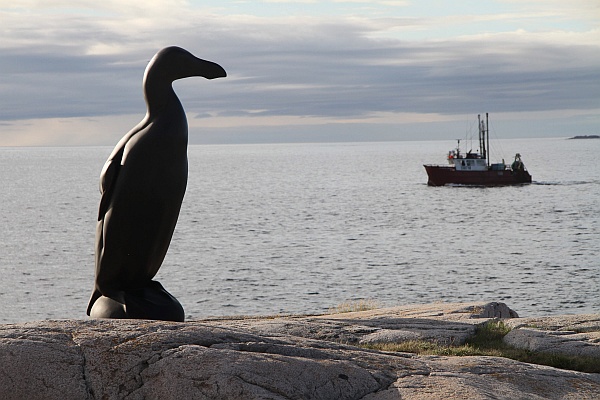This Sunday, July 21, WQED will feature three programs with the theme of Birds Here and Gone.
- 4:00pm, Hummingbirds: Magic in the Air is an old favorite with stunning close-up footage of these tiny flying jewels. See my review here.
- 5:00pm, Bird Tales will air for the first time on WQED. I reviewed it for the original air date in January but we were unable to broadcast it then. See my review here.
- 6:00pm, The Lost Bird Project. Don’t miss this show!
The Lost Bird Project begins slowly, introducing us to sculptor Todd McGrain and his passion for memorializing five extinct birds.
Inspired by the book Hope Is The Thing With Feathers by Christopher Cokinos, McGrain realizes that the birds were driven to extinction by human actions and now other animals are on that same trajectory. Meanwhile we’ve forgotten how this happened. How can we understand what we’ve lost and mitigate the future? He decides to memorialize the birds.
McGrain approaches his mission with humor and poignancy. With his brother-in-law Andy Stern he visits each site where the last bird died, negotiates to place the sculpture, gets to know the local people.
Like the locals we don’t understand it at first. How will this work? Why is it important?
As the show continues all of us “get it.”
The heath hen, similar to the prairie chicken, was hunted until all had died on mainland North America. The last population remained at Martha’s Vineyard where hunting was prohibited, a heath was preserved, and habitat was improved but the heath hen continued to decline. In 1929 the last heath hen called for a mate. His species normally called near the ground but his calls went unanswered. He flew to the top of a tree. He called and called but no one came. He was alone. He died in 1932.
McGain’s sculpture of the great auk, last alive in 1844, gazes out at the North Atlantic from Fogo Island, Newfoundland. This is what we lost. It doesn’t have to be this way. We can do better.
Click here to see the trailer and learn more about The Lost Bird Project.
Don’t miss three bird shows this Sunday, July 21 on WQED. Birds, here and gone.
(photo courtesy of The Lost Bird Project)

Kate – thanks for the heads-up on these three programs. One thought/question on hummingbirds. Last summer we had a large number of hummers, mixed male and female population. So many that we had to move a few of our feeders to other parts of the yard, as one lone male was protecting all of the feeders. They appear every year around the middle of April and sit on the feeder hook looking for food. This year, however, I have only 2 hummers, one male and one female and they never seem to fight over the feeders – of which there are only two feeders this summer. Other friends have noticed only 2 or three and one friend doesn’t have any at her feeder. Did something happen in the migration this year or is this a normal occurrence? I just love watching their antics. Thanks for all the great info on your blog-can’t start my mornings without reading your news.
Kay, I’m not sure where you live so I’ll answer this in a general fashion for the Pittsburgh area.
Ruby-throated hummingbird populations are doing fine but they vary on a local basis from year to year, as do all birds.
Last year we had an extremely hot & dry spring & summer. The flowers bloomed 6 weeks early and then drought took over. The hummers came to your feeders more often because there was less food elsewhere.
This year we’ve had a cooler much wetter spring, even into early July. I’ve noticed lots of flowers blooming and many hummers on patrol in Schenley Park — unlike last year at this time.
Not to worry. They’re around. As the hummers begin migration you may notice an up-tick at your feeders.
You can help track hummingbirds by reporting your sightings at Audubon’s citizen science Hummingbird project called Hummingbirds at Home: http://www.hummingbirdsathome.org/
It’s very wonderful and interesting how they preserved the memory of this lovely bird. I really enjoyed reading the history of how they became extinct….looking forward to reading more of your blog!!